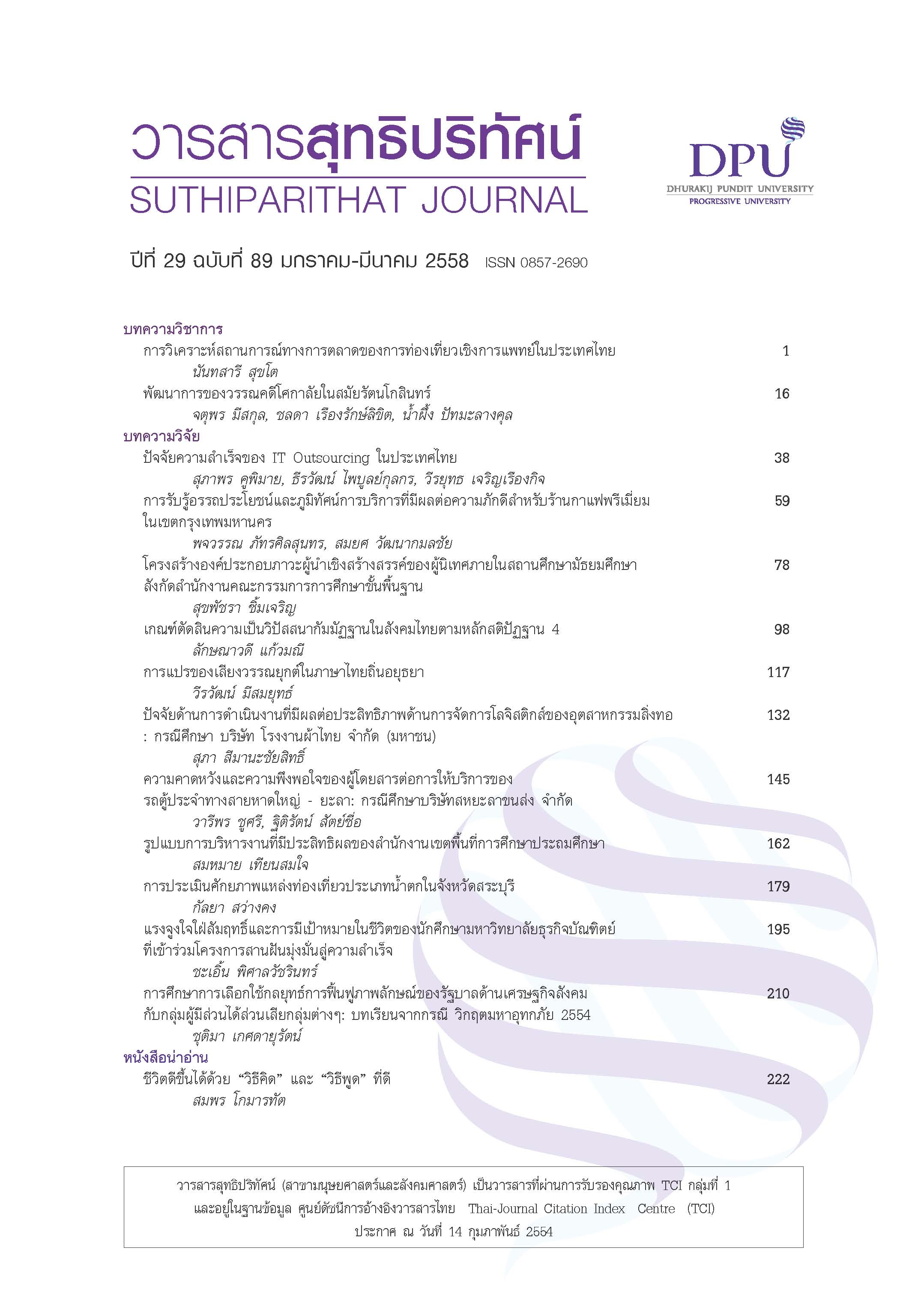โครงสร้างองค์ประกอบภาวะผู้นำเชิงสร้างสรรค์ของผู้นิเทศภายในสถานศึกษามัธยมศึกษาสังกัดสำนักงานคณะกรรมการการศึกษาขั้นพื้นฐาน
คำสำคัญ:
ภาวะผู้นำเชิงสร้างสรรค์, ผู้นิเทศภายในสถานศึกษาบทคัดย่อ
การวิจัยครั้งนี้มีวัตถุประสงค์ 1) เพื่อพัฒนาโครงสร้างองค์ประกอบภาวะผู้นำเชิงสร้างสรรค์ ของผู้นิเทศภายในสถานศึกษามัธยมศึกษา สังกัดสำนักงานคณะกรรมการการศึกษาขั้นพื้นฐาน 2) เพื่อเปรียบเทียบภาวะผู้นำเชิงสร้างสรรค์ของผู้นิเทศภายในสถานศึกษามัธยมศึกษา สังกัดสำนักงานคณะกรรมการการศึกษาขั้นพื้นฐาน จำแนกตามเพศ อายุและประสบการณ์การนิเทศ กลุ่มตัวอย่างประกอบด้วยผู้นิเทศภายในสถานศึกษามัธยมศึกษา สังกัดสำนักงานคณะกรรมการการศึกษาขั้นพื้นฐานจำนวน 504 คน ที่ได้มาโดยวิธีการสุ่มแบบหลายขั้นตอนและการสุ่มอย่างง่าย วิธีวิจัยครั้งนี้ใช้วิธีแบบผสมผสานวิธี (Mixed-Methods Research) เครื่องมือที่ใช้ในการวิจัยเป็นแบบสอบถามแบบมาตราส่วนที่มีค่าความเชื่อมั่นทั้งฉบับมีค่าเท่ากับ 0.96 สถิติที่ใช้ในการวิเคราะห์ ข้อมูล ได้แก่ ค่าความถี่ ค่าร้อยละ ค่าเฉลี่ย ค่าเบี่ยงเบนมาตรฐาน ค่าพิสัย ค่าต่ำสุด ค่าสูงสุด ค่าความเบ้ และค่าความโด่ง การวิเคราะห์องค์ประกอบ การวิเคราะห์ค่าสัมประสิทธิ์สหสัมพันธ์ และทดสอบความมีนัยสำคัญด้วยสถิติทดสอบ t-test และสถิติทดสอบ F - test การวิเคราะห์ข้อมูล ด้วยโปรแกรมคอมพิวเตอร์สำเร็จรูปทางสถิติ มีผลการวิจัย พบว่า 1) โครงสร้างประกอบภาวะผู้นำเชิงสร้างสรรค์ของผู้นิเทศภายในสถานศึกษามัธยมศึกษามีความสัมพันธ์กันโดยมีค่าสัมประสิทธิ์สหสัมพันธ์อยู่ระหว่าง 0.554 - 0.852 อย่างมีนัยสำคัญทางสถิติที่ระดับ .01 2) ภาวะผู้นำเชิงสร้งสรค์ของผู้นิเทศภายในสถานศึกษา ในภาพรวมอยู่ในระดับมาก โดยผู้นิเทศภายใน สถานศึกษาที่เป็นเพชายและเพศหญิงมีความแตกต่างกันอย่างมีนัยสำคัญทางสถิติที่ระดับค่า 0.05 นอกจากนี้ผู้นิเทศภายในสถานศึกษาที่มีอายุต่างกันและมีประสบการณ์ในการนิเทศต่างกันมีภาวะผู้นำ เชิงสร้างสรรค์ไม่แตกต่างกันอย่างมีนัยสำคัญทางสถิติที่ระดับ 0.05
เอกสารอ้างอิง
จิดิมา วรรณศรี, (2550) รูปแบบความสัมพันธ์เชิงสาเหตุของปัจจัยที่ส่งผลต่อวิสัยทัศน์ของผู้บริหารสถานศึกษาขั้นพื้นฐาน (วิทยานิพนธ์ปริญญาดุษฎีบัณฑิต สาขาวิชาการบริหารการศึกษา). พิษณุโลก: มหาวิทยาลัยนเรศวร.
ชาญชัย อาจินสมาจาร. (2555). ภาวะผู้นำในองค์กร. ปัตตานี: สถาบันเพื่อความก้าวหน้าทางวิชาการ.
ดิเรก สุขนัย. (2550). การพัฒนาตัวบ่งชี้และการศึกษาคุณลักษณะความเป็นผู้นำมีวิสัยทัศน์ของบุคลากรทางการศึกษาภาคกลาง. วารสารมหาวิทยาลัยราชภัฏธนบุรี, 1(2), 21-43.
เติมศักดิ์ คทวณิช. (2555). จิตวิทยาทั่วไป กรุงเทพฯ: บริษัท ส. เอเชียเพรส(1989) จำกัด.
นิกัญชลา ล้นเหลือ. (2554). โมเดลสมการโครงสร้างภาวะผู้นำเชิงวิสัยทัศน์ของผู้บริหารสถานศึกษาขั้นพื้นฐาน. (วิทยานิพนธ์ปริญญาดุษฎีบัณทิต สาขาวิชาการบริหารการศึกษา). ขอนแก่น: มหาวิทยาลัยขอนแก่น.
บุญชม ศรีสะอาด. (2545). การวิจัยเบื้องตัน (พิมพ์ครั้งที่ 7). กรุงเทพฯ: สุวิริยาสาสน์.
บุญชม ศรีสะอาดและคณะ. (2544). ปัญหาและแนวทางการพัฒนาการศึกษาขั้นพื้นฐานในระบบโรงเรียนของเขตการศึกษา 11. กรุงเทพฯ : สำนักงานคณะกรรมการวิจัยแห่งชาติ.
ปิยนุช เปี่ยมวิริยวงศ์. (2555). ผลการวิกฤติของหลักสูตรไทย. เอกสารรายงานการศึกษาค้นคว้าอิสระ. กรุงเทพฯ: ม.ป.พ.
พวงรัตน์ ทวีรัตน์. (2540). วิธีการวิจัยทางพฤติกรรมศาสตร์และสังคมศาสตร์. (พิมพ์ครั้งที่ 7). กรุงเทพฯ: สำนักทดสอบทางการศึกษาและจิตวิทยามหาวิทยาลัยศรีนครินทรวิโรฒประสานมิตร.
ไพฑูรย์ สินลารัตน์. (2554). CCPR กรอบคิดใหม่ทางการศึกษา. (พิมพ์ครั้งที่ 2). กรุงเทพฯ: มหาวิทยาลัยธุรกิจบัณฑิตย์.
ยุทธ ไกยวรรณ์. (2556). การวิเคราะห์สถิติหลายตัวแปรสำหรับงานวิจัย. กรุงเทพฯ: สำนักพิมพ์จุฬาลงกรณ์มหาวิทยาลัย.
วิโรจน์ สารรัตนะ. (2555) แนวคิด ทฤษฎีและประเด็นเพื่อการบริหารทางการศึกษา. กรุงเทพฯ: ทิพยวิสุทธิ์.
ศุภกานต์ ประเสริฐรัตนะ. (2555). โมเดลสมการโครงสร้างภาวะผู้นำแบบกระจายอำนาจของผู้บริหารสถานศึกษาขั้นพื้นฐาน (วิทยานิพนธ์ปริญญาดุษฎีบัณฑิต สาขาบริหารการศึกษา). ขอนแก่น: มหาวิทยาลัยขอนแก่น.
สุเทพ พงศ์ศรีวัฒน์. (2545). ภาวะผู้นำ : ทฤษฎีและปฏิบัติ กรุงเทพฯ: บู๊คส์ลิงค์.
สำนักงานสถิติแห่งชาติและสำนักงานกิจการสตรีและสถาบันครอบครัว. (2551). รายงานมิติหญิง-ชาย:ความแตกต่างบนความเหมือน กรุงเทพฯ: ธรรมดาเพรส.
สำนักงานเลขาธิการสภาการศึกษา. (2556). สภาวการณ์การศึกษาไทยในเวทีโลก. กรุงเทพฯ: บริษัทพริกหวานกราฟฟิค.
Coughlin, J. (2005). Principles and Leadership. Englewood Cliffs: Prentice-Hall.
Csiksentmihalyi, M. (1996). Creativity : Flow and the Psychology of Discovery and Invention. Harper Perennial; 4 Tra edition. Retrieved May 9, 1997
Danielson, C. (2007). Enhancing professional practice: A framework for teaching. ASCD.N.P.
Darly, J. M., Glucksberg. S.,Kannin, L.J & Kinchla, R.A. (1991). Psychology. Engleood Cliffs,N.J.: Prentice – Hall.
Gammon, D. & All D. Bragdon. (2010). Building Mental Muscle. USA: Tuttle-Mori Agency.
Garcia Morales, V.J., Llorens Montes, F.J. & Verdu Jover, A.J. (2006). Antecedents and consequences of organizational innovation and organizational learning in entrepreneurship, Industrial Management & Data Systems. 106 (1-2), pp.21-42.
Glickman, C. D. (1990). Supervision Instruction : A Developmental Appraoch. (2nd ed.). Boston : Allyn and Bacon.
Glucksberg, S., & Kinchla, R. A. (1991). Psychology (5th ed.). Englewood Cliffs, N.J.: Prentice Hall
Guntern,H. M. (2004). The Challenge of Creative Leadership. N.P. : Maya Angelou Press.
Harding,T. (2010). Fostering Creativity for Leadership and Leading Change. Journal of Arts Education Policy Review, 111(2), 51-53. Retrieved March 25, 2012, from : http://dx.doi.org/10.1080/106329109034558
Harris, A. (2004). Distributed Leadership and School Improvement: Leading or Misleading? Educational Management Administration and Leadership. Retrieved March 25, 2012, from : www.ema.sagepub.com.
Harris, A. (2009). Behavior in Education. Englewood Cliffs, New Jersey : Prentice – Hall.
Hersey, P. & Blanchard, K. H. (1993). Management of Organization Behavior. Utilizing Human Resources. (6 th ed). Englewoods Cliff, NJ.: Prentice Hall.
Isaksen, S. G. (2011). Managing for innovation: The two faces of tension in creative climates. Creativity and Innovation Management, 19,(4), 73-188
Jung, D. I., Chow, C., Shields, M., & Wu, A. (2003). The role of transformational leadership in enhancing organizational innovation: Hypotheses and some preliminary findings. The Leadership Quarterly, 14 (3), 525–544.
Kagan, J. & Segal, J. (1992). Psychology: An Introduction. (7th ed). Forth Worth : Harcourt Brace Jovanovich.
Kotter,J.P. (1999). Leading Change, Transition & Transformation. Massachusett : Harvard Business School Press.
Kotler,P. & Keller, K.L. (2009). Building strong brands in a modern marketing communications environment. Journal of marketing communications, 15(2-3), 139-155.
Lieberman, A., Saxl, E. R. & Miles, M. B. (2000). Teacher leadership : Ideology and practice In The Jossey-Bass Reader on Educational Leadership. San Francisco : Jossey-Bass.
Lunenburg, F.C. (2011). Leadership versus Management: A Key Distinction - At Least in Theory. Internationl Journal of Mangement, Business, and Administration, 14(1), 144-166.
Mohd Shakir. (2013). Impact of Age, Gender and Length of Experience on The Effectiveness of Secondary School Principals. International Indexed & Refereed Research Journal, 7(46), 40-44.
Mueller, J.S., Goncalo, J. A. & Kamdar, D. (2010). Recognizing creative leadership: Can creative idea expression negatively relate to perceptions of leadership potential? [Electronic version]. Retrieved [insert date]. from : Cornell
University, School of Industrial and Labor Relations.
Mumford, M. D., Scott, G. M., Gaddis, B., & Strange, J. M. (2002). Leading creative people: Orchestrating expertise and relationships. The Leadership Quarterly, 13(6), 705-750.
Neher, A. (1991). Maslow’s Theory of Motivation : A Critique. Journal of Humanistic Psychology, 31(3),p. 89. Retrieved July 31, 1991; from : http://jhp.sagepub.com/cgi/content/abstract.
Office for Standards in Education.(Ofsted). (2000). Improving City Schools : Strategies to Promote Educational Inclusion. London : Ofsted.
Oliva, P.F. & Pawlas, G.E. (2001). Supervision for todays schools. (6th ed) Toronto, ON : John Wiley & Sons.
Plotnik, P. (1989). Introduction to Psychology. (2nd ed.) New York: Rondom House.
Rice. J. W. (2007). Assessing Higher Order Thinking in Video Games. Journal of Technology and Teacher Education, 15(1), 87-100.
Shinn, G. (2005). Leadership Development. N.P.: McGraw-Hill, Inc.
Shin, S.Y. & Park, W. (2013). A study on the effect of goal orientation in superior-subordinate dyad relationship (in Korean). Korean Academy of Management Meeting, April 2013.
Silins, H., & Mulford, B. (2002). Leadership and school results. Second international handbook of educational leadership and administration. Netherlands : Kluwer Academic Publishers.
Simsek, Z., Heavey, C., & Veiga, J.F. (2010). The impact of CEO core self-evaluation on the firm’sentrepreneurial orientation. Strategic Management Journal, 31(1), 110-119.
Spillane, J. P., Halverson, R. & Diamond, J. B. (2004). Towards a theory of leadership practice: A distributed perspective. Journal of Curriclum Studies, 36(1), 3-34.
Sternberg. R. J. (2008). Teaching Critical Thinking , Part 1 Are We Marking Critical Mistake. Phi Delta Kappen, 67(3), 194 – 197.
Stoll, L. & Temperley, J. (2009). Changing our school : Linking school effectiveness and school improvement. Buckingham, Philadelphia : Open University Press.
Stuart, R. & Abett,P.A. (1990). Impact of entrepreneurial and management experience on early performance. Journal of Business Venturing, 5(3), 151-162.
West, M. A. (2002). Sparkling fountains or stagnant ponds: An integrative model of creativity and innovation implementation in work groups. Applied Psychology : An International Review, 51, 355 - 387.
Wrigley, T. (2002). Publishing models and article dates explained Received. British Educational Research Journal, 30(2), 227-244. Retrieved October 15, 2012, from http://www.tandfonline.com.
ดาวน์โหลด
เผยแพร่แล้ว
รูปแบบการอ้างอิง
ฉบับ
ประเภทบทความ
สัญญาอนุญาต
เนื้อหาและข้อมูลในบทความที่ลงตีพิมพ์ในวารสารสุทธิปริทัศน์ ถือเป็นข้อคิดเห็นและความรับผิดชอบของผู้เขียนบทความโดยตรงซึ่งกองบรรณาธิการวารสาร ไม่จำเป็นต้องเห็นด้วย หรือร่วมรับผิดชอบใด ๆ
บทความ ข้อมูล เนื้อหา รูปภาพ ฯลฯ ที่ได้รับการตีพิมพ์ในวารสารสุทธิปริทัศน์ ถือเป็นลิขสิทธิ์ของวารสารสุทธิปริทัศน์หากบุคคลหรือหน่วยงานใดต้องการนำทั้งหมดหรือส่วนหนึ่งส่วนใดไปเผยแพร่ต่อหรือเพื่อกระทำการใด ๆ จะต้องได้รับอนุญาตเป็นลายลักษณ์อักษรจากวารสารสุทธิปริทัศน์ก่อนเท่านั้น







